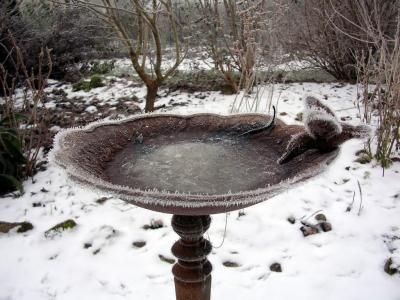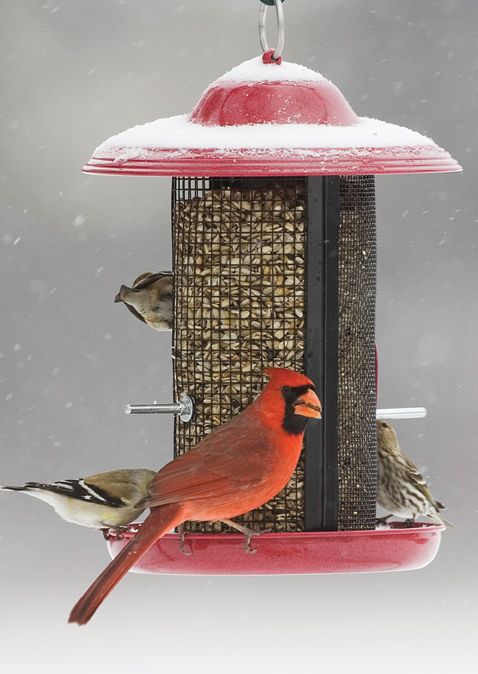Winter Bird Care
Now that winter has arrived, and the colder times of the year are here it is a good time to assess how the birds are doing. If given a little assistance, their chances of survival are greatly increased. Here are some great tips and the supplies you'll need to help our feathered friends with food and shelter during the winter.
Water
 |
| Add a heater or a de-icer to any bird bath to provide much needed open water. |
One of the easiest things to provide, and high on the list of needs, is water. Adding a heater or de-icer coil to an existing bird bath, or purchasing a bird bath with the heater built in, can provide the perfect winter oasis for your feathered friends. Just be sure to keep the bird bath clean. Frequent cleaning with a birdbath cleaning solution and scrub brush and thorough rinsing prior to refilling will ensure a healthy water source.
Shelter
Providing shelter is another way to help. There is a shortage of nesting sites for cavity-nesting birds due to land development, introduction of competing species like starlings, and the use of pesticides. The use of birdhouses and nesting boxes has helped many species make a comeback. Landscaping that provides shelter can also be a great help. Evergreen trees and shrubs provide a welcome resting place out of the wind, snow or rain. Birds gather in groups towards the inside and huddle together to create more warmth. Placing food and water near these nesting or respite areas allows them to make shorter journeys for these things, which means less time battling the elements and using up their energy reserves. More than 50 species of birds will use birdhouses including Chickadees, Bluebirds, Titmice, Woodpeckers, Wrens, Swallows and Nuthatches.
Requirements for a good bird house are:
- Must be able to open it up for cleaning.
- Must have ventilation holes at the bottom. (These should be plugged up for winter roosting.)
- Must have a slanted roof to allow for runoff.
- Must not have perches. Cavity-nesting birds do not need them and they allow predator access to the nest.
Placing the birdhouse on a pole will help discourage predators; however, certain species, like Chickadees and Woodpeckers, prefer nesting in trees, thus attaching the house directly to a tree is what works best for them. The house should face south or southwest so it is facing away from the direction most storms approach. Be sure you have provided a clear flight path to the entrance but approximately 10 feet away from other trees or structures. It should get direct sun for a good part of the day. At the end of the fall, be sure to clean out the old nesting material. Another source of shelter can be provided by your used Christmas tree, particularly if you have few or no other evergreens. Once the holidays are over, take your tree outside and set it up near your house, feeder or winterized birdbath.
 |
| Feeders with platforms help accomodate a larger variety of birds. |
Food
The final piece of the puzzle is providing food. Particularly here in Minnesota, winter is a difficult time for the bird species that have chosen to overwinter here. The days are shorter and colder. There is little to no vegetation, and most of the insects are dead or dormant. Now is an excellent time to purchase a feeder if you do not already have one. Most songbirds feed on insects and spiders during the spring and summer; however, the non-migratory species switch to fruit and seeds in the fall and winter.
Black-oil sunflower seeds are preferred by the largest number of bird species. Not only are these seeds very nutritious and high in fat, but their small size makes them easier for smaller species to split open. Be sure to scatter some seed on the ground and beneath trees and shrubs for birds that prefer to feed in these locations. Other popular choices are golden safflower and thistle. You can find a wide variety of blends and mixes including specially formulated blends that are effective in attracting specific birds like finches, cardinals and woodpeckers.
Feeders with platforms provide the right type of feeding station for species that do not perch, such as cardinals. High energy food, like suet and peanut butter, are an added benefit for all birds and provide much needed fat.
A good supply of food not only attracts birds, but will also attract squirrels. Bird feeder manufacturers have developed a variety of squirrel proof feeders that use unique techniques to keep squirrels away. Another trick to keep squirrels away from the bird food is to apply a hot spicy seed sauce that doesn't bother birds, but squirrels and other mammals hate the hot spice flavor.
